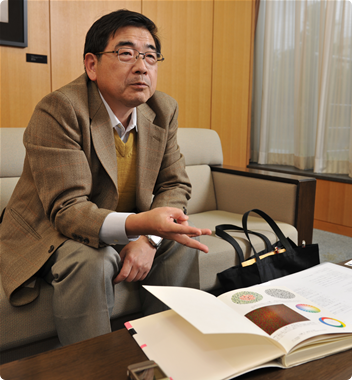Happy to be there at the great revolution of photography.
Focusing on two major subjects: AF and image processing.
How did you progress development of the AF line of products at Nikon after the F3AF?
We determined two methods of creating future AF models. One was to develop an AF camera borrowing an AF module produced by an outside company. The other was to develop an AF camera and AF module together using Nikon’s own technologies. The project group using the first method successfully produced the F-501, and launched it in 1986. The F-501 became Nikon’s first TTL SLR camera built with an AF function inside its body. The other project group launched its first AF model, the F-401, in 1987, developed by employing Nikon’s own AF technologies. Every Nikon AF camera thereafter employed only Nikon-exclusive AF modules
It must give you great pleasure when you succeed in developing a new product after many painstaking efforts.
Not immediately. It is only that we succeeded with a product development at that stage. Afterwards, we need to place it in the market, and win a good reputation for it from our customers. It is only then that we can celebrate our success. Cameras are used in various conditions. The lenses utilized at different shooting locations and the subjects photographed also greatly vary. It is very unpredictable what will happen at the exact place and point in time that a photograph is taken.
In addition to AF development, you also have a great record of achievements in image processing. When did you first join the development project for this technology?
Around the time of our AF development, I discovered that the industry was rapidly entering the age of digital image processing. Nikon did not have extensive experience in this area of business at the time. Once I was confident that AF development was successfully progressing, I decided to become involved with the development of image processing technologies.
So, the trends of digital technologies involved you in the development of image processing technologies.
The advent of the digital camera concept had a strong influence. Film camera technology was firmly established in terms of mechanism and lens performance. However, possessing this knowledge of film cameras alone was not sufficient in the development of a digital camera. That’s when the performance ability of an image sensor became the principal issue of concern, while the software for image processing drastically increased its importance. As a result, our researchers’ subjects of study were transformed in line with such different requirements.
Sensory analysis is the key to breakthroughs in digital processing.
What is the difference between the development of image processing and that of AF technology?
There’s no really essential difference between the two because both deal with digital signals, utilizing digital processing software and technologies. However, AF focuses on electronic measurement, while image processing is concerned with how the human eye judges the quality of the final image rendition. The latter is a matter of sensory preference. Measurement by electronics and human judgment are the major basic differences between the two. Logic alone will not produce the best solutions for image processing.
How is an image produced in digital photography?
Digital color cameras generally use an image sensor that utilizes a Bayer*1 array, in which filters of each of three color pixels of red (R), green (G) and blue (B) are placed in lines. In order to faithfully reproduce colors from the photographic subject, a technology called interpolation*2 is used to compensate for the colors lost in the filtering process. Colors are compensated for, computed from an estimation of the colors that may have been lost nearby. If this estimate is incorrect, the wrong colors will appear, and the reproduced image looks quite different from the original subject.

This is where sensory analysis is required, isn’t it?
Yes. At the stage of interpolation, first of all, efforts are focused on faithful reproduction of colors. However, what we have to take note of here is that completely faithful reproduction is not necessarily what our users want. For example, a camera user may want in his or her picture a facial expression with an added tint of healthier skin colors. We know from our experience that camera users tend to like more vivid tints of colors than are really present in photos of natural landscapes. Generally speaking, users prefer photographic images that project the colors and expressions that satisfy their sensory likings rather than those reproduced more faithfully from the original according to electronic measurement.
So, your career as a researcher ran alongside a dramatic revolution in the camera industry, as it experienced a radical shift to autofocus and digital cameras.
The evolution of camera technologies is still continuing and always will, but I was indeed happy to be at the heart of it during the great shift of the industry from analog film to AF and digital photography, which was rare to experience even for a researcher at the forefront of technology.
- *1Bayer array: When the image sensor’s total number of pixels is N, the RGB color filters in a Bayer filter configuration are arrayed at an equal, proportionate distance, with greens occupying half of the total number (N/2) and reds and blues making up one fourth each (N/4).
- *2Interpolation: Compensation for missing colors in a color filter configuration such as the Bayer filter array, of which each filter is composed of one pixel color.
